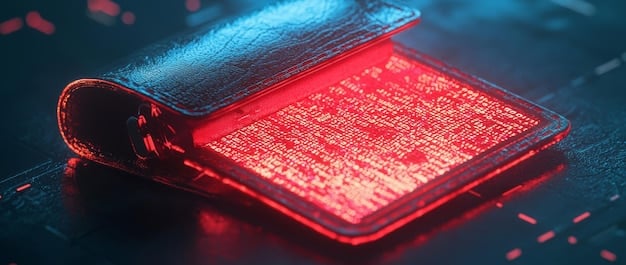How Secure is Your Crypto Wallet in 2025? US Digital Security Standards

Ensuring the security of your crypto wallet in 2025 involves understanding and implementing the latest US digital security standards, including advanced encryption, multi-factor authentication, and robust regulatory compliance to protect against evolving cyber threats.
As we approach 2025, the question of **how secure is your crypto wallet in 2025? A deep dive into US digital security standards** becomes increasingly critical. With the rising adoption of cryptocurrencies, understanding the safeguards that protect your digital assets is paramount. This article delves into the US digital security standards shaping the future of crypto wallet security, providing insights into the measures you can take to fortify your defenses.
Understanding the Evolving Threat Landscape for Crypto Wallets
The digital realm is constantly evolving, and with it, so are the threats targeting cryptocurrency wallets. As we move closer to 2025, it’s vital to grasp the changing landscape of cyber threats and vulnerabilities to effectively protect your crypto assets.
Sophisticated Phishing Attacks
Phishing attacks have become increasingly sophisticated, employing tactics that are harder to detect. Cybercriminals craft emails and websites that closely mimic legitimate platforms, tricking users into divulging their private keys and sensitive information.
Malware and Keyloggers
Malware specifically designed to target crypto wallets is on the rise. Keyloggers, another significant threat, record every keystroke a user makes, potentially capturing passwords and private keys.
After identifying the types of threats, consider the following measures to mitigate the risk:
- Implement Multi-Factor Authentication (MFA): Adds an extra layer of security, reducing the risk of unauthorized access.
- Use Hardware Wallets: Store your private keys offline, making them less vulnerable to online attacks.
- Regularly Update Software: Keep your operating system and wallet software updated with the latest security patches.

In conclusion, understanding the evolving threat landscape is the first step in securing your crypto wallets. By staying informed and taking proactive measures, you can significantly reduce your risk and protect your digital assets from cyber threats.
The Role of US Digital Security Standards in Crypto Wallet Protection
US digital security standards play a crucial role in shaping the security landscape for crypto wallets. These standards, often developed by organizations like NIST (National Institute of Standards and Technology), provide a framework for secure data handling and cryptographic practices.
NIST Cybersecurity Framework
The NIST Cybersecurity Framework offers guidance for organizations to manage and reduce cybersecurity risks. It includes standards, guidelines, and best practices to protect critical infrastructure and digital assets.
Compliance and Regulations
Compliance with US regulations, such as those related to anti-money laundering (AML) and data protection, is essential for crypto wallet providers. Failure to comply can result in significant penalties and legal consequences.
Keeping up with the current regulations is critical. Consider the following practices for regulatory compliance:
- Implement KYC/AML Procedures: Verify the identity of your users and monitor transactions for suspicious activity.
- Ensure Data Encryption: Use strong encryption algorithms to protect sensitive data both in transit and at rest.
- Regular Security Audits: Conduct regular audits to identify vulnerabilities and ensure compliance with security standards.
In conclusion, US digital security standards provide a robust framework for protecting crypto wallets. By adhering to these standards and maintaining compliance with relevant regulations, wallet providers and users can enhance their security posture and mitigate risks effectively.
Key Technological Advancements Enhancing Crypto Wallet Security
Technological advancements are continually enhancing the security of crypto wallets, offering new defenses against increasingly sophisticated cyber threats. Staying abreast of these developments is crucial for maintaining a high level of security for your digital assets.
Multi-Party Computation (MPC)
MPC allows multiple parties to jointly compute a function over their inputs while keeping those inputs private. This technology can be used to secure private keys by distributing them across multiple locations, making it harder for attackers to compromise them.
Hardware Security Modules (HSMs)
HSMs are tamper-resistant hardware devices that securely store cryptographic keys. They provide a high level of protection against physical and logical attacks, making them ideal for securing crypto wallet keys.

Here are some additional technological advancements that can greatly enhance security:
- Biometric Authentication: Use fingerprint or facial recognition to protect access to your wallet.
- Blockchain Analytics: Monitor transactions for suspicious activity and potential security breaches.
- Secure Enclaves: Utilize secure enclaves within processors to protect sensitive data from unauthorized access.
In closing, these technological advancements are revolutionizing the security of crypto wallets. By adopting these technologies, crypto wallet providers and users can significantly enhance their defenses against cyber threats and ensure the safety of their digital assets.
Multi-Factor Authentication (MFA) and Biometric Security in Crypto Wallets
Multi-Factor Authentication (MFA) and biometric security are vital components of a robust security strategy for crypto wallets. These measures add additional layers of protection, making it significantly harder for unauthorized users to access your digital assets.
The Importance of Multi-Factor Authentication
MFA requires users to provide multiple verification factors, such as a password and a one-time code from a mobile app, to access their wallets. This reduces the risk of unauthorized access, even if a password is compromised.
Benefits of Biometric Security
Biometric security, such as fingerprint scanning and facial recognition, provides a convenient and secure way to authenticate users. Biometric data is unique to each individual, making it difficult to forge or replicate.
Consider the following practices to improve MFA and Biometric Security:
- Enable MFA on All Accounts: Protect your email, exchanges, and wallets with multi-factor authentication.
- Use a Strong Authentication App: Opt for authentication apps with robust security features, such as end-to-end encryption.
- Regularly Review Biometric Data: Ensure your biometric data is up-to-date and accurate to prevent access issues.
In conclusion, MFA and biometric security are essential for protecting crypto wallets from unauthorized access. By implementing these measures, you significantly enhance the security of your digital assets and reduce the risk of theft.
Best Practices for Secure Crypto Wallet Management in 2025
Effective crypto wallet management involves a series of best practices that, when implemented consistently, can significantly enhance the security of your digital assets. These practices cover everything from choosing the right wallet to safeguarding your private keys.
Choosing the Right Wallet Type
Different types of wallets offer varying levels of security and convenience. Hardware wallets are generally considered the most secure, as they store private keys offline. Software wallets, while convenient, are more vulnerable to online attacks.
Safeguarding Your Private Keys
Your private key is the most critical piece of information for accessing your crypto assets. It should be stored securely, preferably offline, and never shared with anyone.
Follow these best practices:
- Regularly Update Software: Keep your wallet software updated with the latest security patches.
- Use Strong Passwords: Create strong, unique passwords for your wallets and accounts.
- Backup Your Wallet: Regularly back up your wallet in case of hardware failure or other unforeseen events.
In conclusion, secure crypto wallet management requires a proactive approach and adherence to best practices. By following these guidelines, you can significantly reduce your risk and protect your digital assets from cyber threats.
The Future of Crypto Wallet Security: Trends and Predictions for 2025
The future of crypto wallet security is poised for significant advancements, driven by emerging trends and innovative technologies. Looking ahead to 2025, we can anticipate even greater emphasis on security, privacy, and user experience.
Increased Adoption of Decentralized Identity (DID)
DID solutions will likely become more prevalent, allowing users to manage their digital identities and control access to their crypto wallets without relying on centralized authorities.
Integration of AI and Machine Learning
AI and machine learning technologies will play a greater role in detecting and preventing cyber threats, identifying anomalous activity, and enhancing overall security.
More trends to watch for:
- Quantum-Resistant Cryptography: Protecting against future quantum computing threats
- Enhanced Privacy Features: Privacy-focused wallets and transactions
- Cross-Chain Security: Secure interoperability between different blockchain networks
In conclusion, the future of crypto wallet security is bright, with emerging trends and technologies promising to enhance security, privacy, and user experience. As we approach 2025, staying informed and adapting to these advancements will be key to protecting your digital assets.
| Key Point | Brief Description |
|---|---|
| 🛡️ Threat Landscape | Evolving cyber threats require proactive security measures. |
| 🏛️ US Standards | Compliance with NIST and AML regulations is crucial. |
| 🚀 Tech Advancements | MPC, HSMs, and Biometrics enhance wallet security. |
| 🔒 Best Practices | Secure key management and regular software updates are vital. |
Frequently Asked Questions (FAQ)
▼
MFA requires multiple verification methods to access your wallet, adding a crucial security layer. Even if your password is compromised, unauthorized access is significantly harder.
▼
Hardware wallets store your private keys offline, making them immune to online hacking attempts. They are considered one of the most secure ways to manage your crypto assets.
▼
US digital security standards, like those from NIST, provide a framework for secure data handling and cryptographic practices, helping to ensure that crypto wallets meet high security benchmarks.
▼
Be cautious of suspicious emails, verify website URLs, and never share your private keys or seed phrases. Always enable MFA for added security.
▼
AI will enhance threat detection by spotting anomalous activity. It will help enhance overall security, making your wallet safer from evolving cyber threats by 2025.
Conclusion
Securing your crypto wallet in 2025 requires a multifaceted approach, combining an understanding of the evolving threat landscape with adherence to US digital security standards and the adoption of cutting-edge technologies. By implementing best practices and staying informed, you can protect your digital assets and navigate the future of cryptocurrency with confidence.





